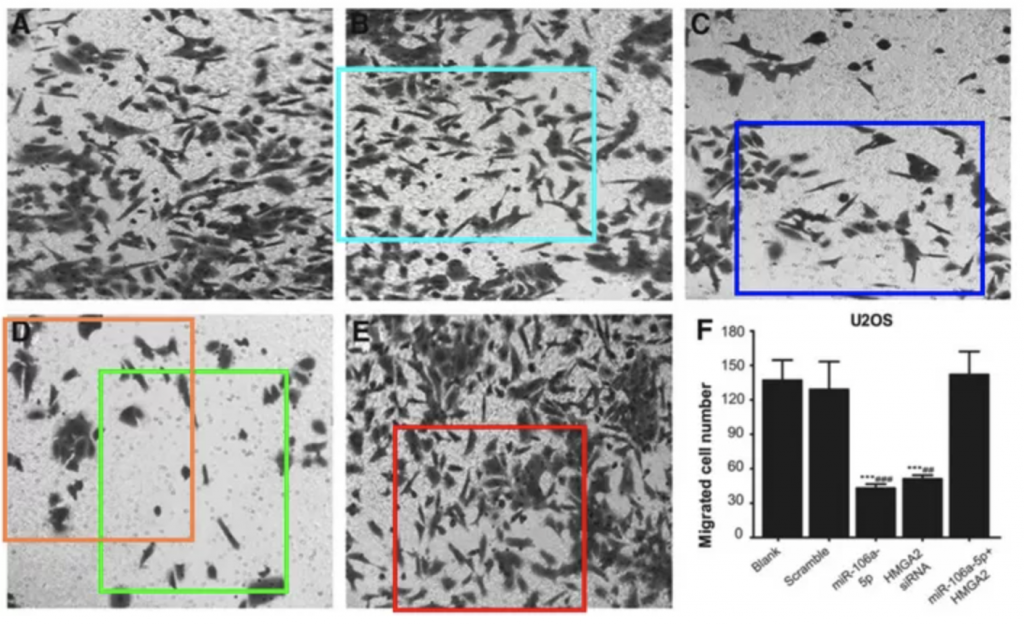
Pro tip to would-be fraudsters: If you’re going to submit new figures to support your claims, make sure they’re not obviously fake.
That’s a lesson a group of cancer researchers learned the hard way for their 2016 article in DNA and Cell Biology titled “miR-106a-5p suppresses the proliferation, migration, and invasion of osteosarcoma cells by targeting HMGA2.” The corresponding author was Fang Ji, of The Second Military Medical University in Shanghai.
The paper appeared on PubPeer earlier this year, where a commentor noted dryly:
It is difficult to show all the connections among Bai et al (2016) (Fig 4A), Li et al (2016) (Figs 7 and 12), and He et al (2016) (Figs 13 and 14) without running rapidly out of colors.
As the notice explains, Ji tried to correct one of the images in the article — which proved to be its undoing:
DNA and Cell Biology officially retracts the paper entitled, “miR-106a-5p Suppresses the Proliferation, Migration, and Invasion of Osteosarcoma Cells by Targeting HMGA2,” by Qian-Yun He, Guang-Chao Wang, Hao Zhang, Da-Ke Tong, Chen Ding, Kang Liu, Fang Ji, Xiongbai Zhu, and Shengwu Yang. DNA Cell Biol, 35(9) 506–520; DOI: 10.1089/dna.2015.3121, due to suspicion of scientific misconduct.
The corresponding author, Dr. Fang Ji, contacted the journal via email, and requested a correction be made to Figure 8A, indicating, “When I recently collated the results of the project, I found that in the immunofluorescence experiment, as I used several folders to store pictures but the naming was not standardized, the pictures of other groups in Figure 8A scramble group, hmega2 siRNA group, mir-106a-5p + hmega2 group were misused. [sic]”
The email also contained a new figure, however, upon examination by the Editor, it was clear that there were differences between the published figure and the replacement figure. There was clear duplication of lanes in the Western blot figure. The author was then asked to provide further explanation, and Dr. Ji’s response was, “Figure 8 A scramble group, hmega2 siRNA group and mir-106a-5p + hmega2 group used the wrong pictures of other groups, and provided the three groups of pictures again [sic].” This response did not address the confusion and several other requests for clarification were made, but went unanswered. The lack of response for clarification concerned the Editor who then re-reviewed the request again, which resulted in the discovery that additional problematic images were raised on the PubPeer platform1 and believes that the authors are now eager to correct them as there appears to be clear scientific misconduct with respect to digital manipulation of figures. Considering the available evidence and lack of further details from the authors, the Editor officially retracts the article from the journal.The Editor and Publisher of DNA and Cell Biology are committed to preserving the scientific literature and the community it serves.
Like Retraction Watch? You can make a tax-deductible contribution to support our work, follow us on Twitter, like us on Facebook, add us to your RSS reader, or subscribe to our daily digest. If you find a retraction that’s not in our database, you can let us know here. For comments or feedback, email us at [email protected].
“Molecular mechanisms of disease full access miR-106a-5p suppresses the proliferation, migration, and invasion of osteosarcoma cells by targeting HMGA2.”
The first six words seem to have strayed in from somewhere else; they are not part of the title.
It feels like you have missed out the lede here – that is, the appearance of the same images in other papers from multiple other research teams. Indicating that they all bought their work from the same paper-mill.
Title fixed, thanks for flagging that. Might have been an odd HTML thing on cut and paste, but we should have caught it.
RW: ” If you’re going to submit new figures to support your claims, make sure they’re not obviously fake. ”
Is that how you read the retraction notice? I read it as saying that they realized the original images were obviously fake. But it’s a somewhat confusingly written notice.
My reading of the notice is that Fang Ji wanted to replace Figures (having received a message, through the PubPeer automated system, inviting the authors to participate in the conversation). Ji’s replacement figures were not entirely convincing, and aroused the suspicions of the editors, inspiring them to read the criticisms at PubPeer.
Some would say that the critical contributor(s) to PubPeer should have notified the journal editors right at the start, but sometimes it isn’t that easy.
The original offending figures overlap with other figures found (so far) in 16 other papers, as described here.
http://eusa-riddled.blogspot.com/2020/09/trouble-down-at-tmill.html
“Some would say that the critical contributor(s) to PubPeer should have notified the journal editors right at the start, but sometimes it isn’t that easy.”
Frankly the journals make this step
a pain in the ass (as you know). Even after searching for editors’ addresses and alerting them, I’ll seldom get a response and only occasionally see any action taken. In my case, I write anonymously so that probably discourages replies.
Wish COPE would add a requirement to make a research integrity email address publicly available on the journal site and to require acknowledgment when a concern is reported.
This unfair for the authors
Where are the peer review from the first recieve of the paper to the journal. The journal like this must be retracted from the database not the paper
You are correct that the editors and reviewers missed the apparent fraud at the time of original submission, but that’s no reason to leave a severely flawed paper published in the scientific literature.
The authors are responsible for submitting a paper that seems to contain results of experiments that they did not conduct.